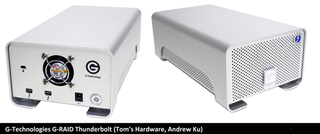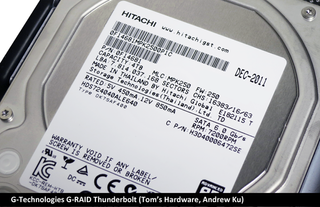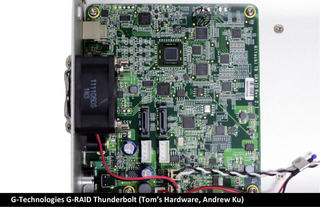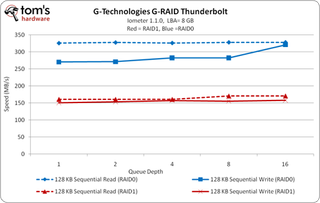Nine External Thunderbolt Storage Devices, Rounded Up
G-Technologies G-RAID Thunderbolt 8 GB

| G-RAID Thunderbolt | 4 TB (0G02289) | 8 TB (0G02272) |
|---|---|---|
| MSRP | $700 | $1000 |
G-Technologies is a subsidiary of Hitachi Global Storage Technologies, which was acquired by Western Digital a few months ago. We're told there are no plans to discontinue Hitachi GST's products. But, should that occur, Western Digital will continue to honor warranty coverage, alleviating concerns over buying a G-Technologies device.
The G-RAID Thunderbolt is housed in a silver-colored MacBook Pro-like aluminum shell, with two ports located on the back for daisy chaining, along with a power switch and fan exhaust port. The combination of an active cooler fan and an aluminum housing seems fairly effective for dissipating the heat from Intel's Thunderbolt controller and the installed hard drives. At idle and during our streaming write tests, the unit remained cool, and we're happy to say its fan runs more quietly than the mechanical disks.

The two internal 4 TB 3.5” Hitachi Deskstar 7K4000 hard drives occupy three-quarters of the length of the unit, and both repositories are positioned near the front grill. Not all G-RAID Thunderbolt units feature the configuration we're reviewing today. G-Technology also offers 4 TB (2 x 2 GB) and 6 TB (2 x 3 GB) versions employing Hitachi’s Deskstar 7K2000 and 7K3000 family, respectively. All three capacities are rated for similar performance, so your only real decision is how much storage space you need.
Upgrading the installed hard drives on your own voids the warranty, so it may be wise to err on the side of caution and buy bigger if you anticipate a rapidly-growing library of music or videos eating up capacity quickly. There is no way to sneak around this restriction, as a tamper-resistant sticker hides one of the screws required to disassemble the chassis.

Unlike the Elgato unit, G-Technology uses Intel's CV82524EF/L Thunderbolt controller, equipped with four channels, to facilitate support for daisy chaining. Also unlike the Elgato unit, the G-RAID Thunderbolt forgoes ASMedia's storage controller in favor Marvell's 88SE9182 SATA 6Gb/s solution.
There is no hardware-based RAID controller on-board. So, you have to configure RAID via software either in Windows or using OS X's Disk Utility. That's an important note, since G-Technology incorrectly claims that this device supports hardware-based RAID 0 on its product webpage.

Configured manually to operate in RAID 0 mode, the G-RAID Thunderbolt reaches sequential read speeds of ~325 MB/s, regardless of queue depth. Sequential writes, on the other hand, start out at ~270 MB/s and jump to 320 MB/s once there are sixteen concurrent operations.
Stay on the Cutting Edge
Join the experts who read Tom's Hardware for the inside track on enthusiast PC tech news — and have for over 25 years. We'll send breaking news and in-depth reviews of CPUs, GPUs, AI, maker hardware and more straight to your inbox.
Sequential write performance hangs steady at 155 MB/s in RAID 1, and sequential reads climb from 50 MB/s to ~160 MB/s.
Current page: G-Technologies G-RAID Thunderbolt 8 GB
Prev Page Elgato Thunderbolt SSD 240 GB Next Page LaCie Little Big Disk 240 GB-
acku Reply9535164 said:No benchmark for 8-drive Thunderbolt deivces such as Areca ARC-8050 ?
What the R6 isn't expensive enough? :p Honestly, we couldn't include the ARC-8050 (http://www.areca.com.tw/products/thunderbolt.htm) because it's not readily available for purchase (yet).
Cheers,
Andrew Ku
TomsHardware.com -
mayankleoboy1 storage is OK, but an externally powered GPU is the most interesting application of thunderbolt.Reply
with the external PCI-E device specification coming soon, i believe the days of thunderbolt are limited. -
web2dot0 mayankleoboy1storage is OK, but an externally powered GPU is the most interesting application of thunderbolt.with the external PCI-E device specification coming soon, i believe the days of thunderbolt are limited.Reply
Thunderbolt IS ePCI-E. Well, using Intel's implementation. You think the specification will somehow make things cheaper? Nope. -
chovav Thank you Andrew for this review, it certainly makes it clear whether you should invest in thunderbolt or not.Reply
Could you maybe do add a random read/write graph comparing GoFlex Desk with USB3 and Thunderbolt?
I was also wondering what the CPU usage is during read/write - is there any impact at all? or does the thunderbolt controller bear all the processing grunt-work?
Thanks again, great article. -
CaedenV web2dot0Thunderbolt IS ePCI-E. Well, using Intel's implementation. You think the specification will somehow make things cheaper? Nope.thunderbolt is a medium that allows for multiple interconnect protocols to be transmitted over the same wire. It can send PCIe, it can send DP, it was supposed to be able to send USB 1/2/3, as well as Ethernet, all over the same wire... but we have not seen that happen over the copper version that was released.Reply
The external PCIe will be cheaper and easier because it will be hosted directly by the mobo chipset, or the CPU by tapping into already existing hardware. Chip makers will not have to add a new and expensive tech to the device, the connection will just siphon off lanes that are already there. And because it is already standardized and cheap technology it will be easier and cheaper to implement. Finally it will be an open standard that multiple manufacturers can adopt. Thunderbolt (as much as I love the idea) is made and operated by Intel, and Intel wants to charge a premium for it. Until there are multiple chip makers who can make it, then it will continue to be too expensive... and when multiple chip makers can make it then Intel will be the only one worth buying (much like their network interfaces) because nobody can do quality like intel, but at least the price will come down. -
mayankleoboy1 ^ like the Marvell SATA controllers.Reply
And thunderbolt is not going optical fibre in the coming years. the cable is too expensive and cant carry much power.
and the fact that apple is using it gives some clues about its price, compatibility, usability and openness.
i remember how TB was promoted : one single wire from your PC to a TB brick. and from that brick you added USB, ethernet, firewire, DP, HDMI. basically it was touted as "1 wire for everything". supposed to be magical, and we all know how that turns out.
-
acku CaedenVthunderbolt is a medium that allows for multiple interconnect protocols to be transmitted over the same wire. It can send PCIe, it can send DP, it was supposed to be able to send USB 1/2/3, as well as Ethernet, all over the same wire... but we have not seen that happen over the copper version that was released.The external PCIe will be cheaper and easier because it will be hosted directly by the mobo chipset, or the CPU by tapping into already existing hardware. Chip makers will not have to add a new and expensive tech to the device, the connection will just siphon off lanes that are already there. And because it is already standardized and cheap technology it will be easier and cheaper to implement. Finally it will be an open standard that multiple manufacturers can adopt. Thunderbolt (as much as I love the idea) is made and operated by Intel, and Intel wants to charge a premium for it. Until there are multiple chip makers who can make it, then it will continue to be too expensive... and when multiple chip makers can make it then Intel will be the only one worth buying (much like their network interfaces) because nobody can do quality like intel, but at least the price will come down.Reply
Read http://www.tomshardware.com/reviews/thunderbolt-performance-z77a-gd80,3205.html Thunderbolt can externalize anything. It just has to have the controller. It is external PCIe. External USB 3.0 and ethernet are possible but unlikely because they are already on the mobo.
From a practical standpoint, external PCIe may cheaper, but it's pointless from a performance standpoint http://en.wikipedia.org/wiki/PCI_Express#External_PCIe_cards. Everything is limited to a PCIe 1.0 x1 connection. The new ExpressCard standard (v2.0) ups bandwidth to slightly more than PCIe 1.0 x2, which still isn't that fast compared to TB (PCIe 2.0 x4 uplink). Plus ExpressCard only lets you connect a single device. It's one and done after that. For a mobile user, Thunderbolt is the way to go. Worse, you can't count on EC to be available. I'm already seeing Ultrabooks with TB. It makes sense because it doesn't require a lot of space. EC requires more space, hence it will be a greater rarity now that TB is out.
It looks expensive now but be patient. TB is something you will want. Many people need to look past the role Apple played. It clearly is a performance oriented technology that opens up a whole new world, especially on the mobile side.
Cheers,
Andrew Ku
Tom's Hardware.com
-
web2dot0 CaedenVthunderbolt is a medium that allows for multiple interconnect protocols to be transmitted over the same wire. It can send PCIe, it can send DP, it was supposed to be able to send USB 1/2/3, as well as Ethernet, all over the same wire... but we have not seen that happen over the copper version that was released.The external PCIe will be cheaper and easier because it will be hosted directly by the mobo chipset, or the CPU by tapping into already existing hardware. Chip makers will not have to add a new and expensive tech to the device, the connection will just siphon off lanes that are already there. And because it is already standardized and cheap technology it will be easier and cheaper to implement. Finally it will be an open standard that multiple manufacturers can adopt. Thunderbolt (as much as I love the idea) is made and operated by Intel, and Intel wants to charge a premium for it. Until there are multiple chip makers who can make it, then it will continue to be too expensive... and when multiple chip makers can make it then Intel will be the only one worth buying (much like their network interfaces) because nobody can do quality like intel, but at least the price will come down.Reply
Thank you for your Wikipedia quote. Everybody can quote from the spec sheet. The trouble is you make it seem like Intel are bunch of morons building a interconnect that nobody uses. That's is plain wrong. Just like SSDs, they will come down in price and next thing you know, you'll be asking yourself why in the world would I not use Thunderbolt. Imagine running a external GPU on your Retina Display MacbookPro when you dock your laptop. There'll be a lineup of people buying that technology at a premium price.
Partnering with Apple is no accident. 2 giant corporations backing the initiative is nothing to sneeze at. Give it a few years, and you'll soon find out the true power of Thunderbolt. USB 3.0 complements Thunderbolt.
Most Popular

